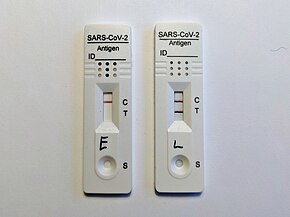
Back الاختبار المستضد السريع لكوفيد-19 Arabic Бърз антигенен тест COVID-19 Bulgarian Rychlý antigenní test na covid-19 Czech COVID-19 γρήγορη δοκιμή αντιγόνου Greek Prueba rápida de antígeno COVID-19 Spanish COVID-19 antigeeni kiirtestid Estonian آزمایش سریع آنتیژن کووید ۱۹ Persian COVID-19-pikatestit Finnish Proba rápida de antíxeno COVID-19 Galician Gwajin COVID-19 Cikin Saurin Antigen Hausa
| COVID-19 rapid antigen test | |
|---|---|
 Negative (left, showing Control line) and positive (right, showing Control and Test lines) results | |
| Synonyms | SARS-CoV-2 or COVID-19 antigen test, rapid antigen detection test (RADT), lateral flow test (LFT), lateral flow device (LFD), antigen-detecting rapid diagnostic test (Ag-RDT), antigen rapid diagnostic test (Antigen-RDT), point of care (POC) test, rapid test[a] |
| Purpose | To diagnose SARS-CoV-2 infections (COVID-19) |
| LOINC | 94558-4, 95209-3, 96119-3, 97097-0 |
COVID-19 rapid antigen tests or RATs, also frequently called COVID-19 lateral flow tests or LFTs, are rapid antigen tests used to detect SARS-CoV-2 infection (COVID-19). They are quick to implement with minimal training, cost a fraction of other forms of COVID-19 testing, and give users a result within 5–30 minutes. RATs have been used in several countries as part of mass testing or population-wide screening approaches.[1] Many RATs can be used for self-testing, in which an individual "collects their own specimen… and interpret[s] their test result themselves".[2]
False positives are very rare; the tests' specificity is 98%-99%.[3][4][5] However, the tests have a sensitivity of 70%-72%,[3][4][5] which is lower than COVID-19 polymerase chain reaction (PCR) tests' sensitivity of 88%-96%.[6][7][b] Despite this, COVID-19 RATs remain valuable in finding people who would otherwise not know they were infected, helping to prevent further transmission. The tests are more sensitive in the symptomatic and transmissive stages of disease when the viral load is higher.[3][4][5][8][9]
Cite error: There are <ref group=lower-alpha> tags or {{efn}} templates on this page, but the references will not show without a {{reflist|group=lower-alpha}} template or {{notelist}} template (see the help page).
- ^ Kahanec M, Lafférs L, Schmidpeter B (2021). "The impact of repeated mass antigen testing for COVID-19 on the prevalence of the disease". J Popul Econ. 34 (4): 1105–1140. doi:10.1007/s00148-021-00856-z. PMC 8241209. PMID 34219976.
- ^ Use of SARS-CoV-2 antigen-detection rapid diagnostic tests for COVID-19 self-testing. Interim guidance (Report). World Health Organization (WHO). 9 March 2022. hdl:10665/352350. WHO/2019-nCoV/Ag-RDTs/Self_testing/2022.1.
- ^ a b c Khalid MF, Selvam K, Jeffry AJ, Salmi MF, Najib MA, Norhayati MN, et al. (4 January 2022). "Performance of Rapid Antigen Tests for COVID-19 Diagnosis: A Systematic Review and Meta-Analysis". Diagnostics. 12 (1): 110. doi:10.3390/diagnostics12010110. PMC 8774565. PMID 35054277.
- ^ a b c Brümmer LE, Katzenschlager S, McGrath S, Schmitz S, Gaeddert M, Erdmann C, et al. (26 May 2022). "Accuracy of rapid point-of-care antigen-based diagnostics for SARS-CoV-2: An updated systematic review and meta-analysis with meta-regression analyzing influencing factors". PLOS Med. 19 (5): e1004011. doi:10.1371/journal.pmed.1004011. PMC 9187092. PMID 35617375.
- ^ a b c Tapari A, Braliou GG, Papaefthimiou M, Mavriki H, Kontou PI, Nikolopoulos GK, et al. (4 June 2022). "Performance of Antigen Detection Tests for SARS-CoV-2: A Systematic Review and Meta-Analysis". Diagnostics. 12 (6): 1388. doi:10.3390/diagnostics12061388. PMC 9221910. PMID 35741198.
- ^ Pecoraro V, Negro A, Pirotti T, Trenti T (2022). "Estimate false-negative RT-PCR rates for SARS-CoV-2. A systematic review and meta-analysis". Eur J Clin Invest. 52 (2): e13706. doi:10.1111/eci.13706. PMC 8646643. PMID 34741305.
- ^ Pu R, Liu S, Ren X, Shi D, Ba Y, Huo Y, et al. (2022). "The screening value of RT-LAMP and RT-PCR in the diagnosis of COVID-19: systematic review and meta-analysis". J Virol Methods. 300: 114392. doi:10.1016/j.jviromet.2021.114392. PMC 8629515. PMID 34856308.
- ^ "Oxford University and PHE confirm lateral flow tests show high specificity and are effective at identifying most individuals who are infectious". Oxford University. 11 November 2020. Archived from the original on 17 July 2021. Retrieved 19 May 2021.
- ^ Guglielmi G (2020). "Fast coronavirus tests: what they can and can't do". Nature. 585 (7826): 496–498. Bibcode:2020Natur.585..496G. doi:10.1038/d41586-020-02661-2. PMID 32939084.